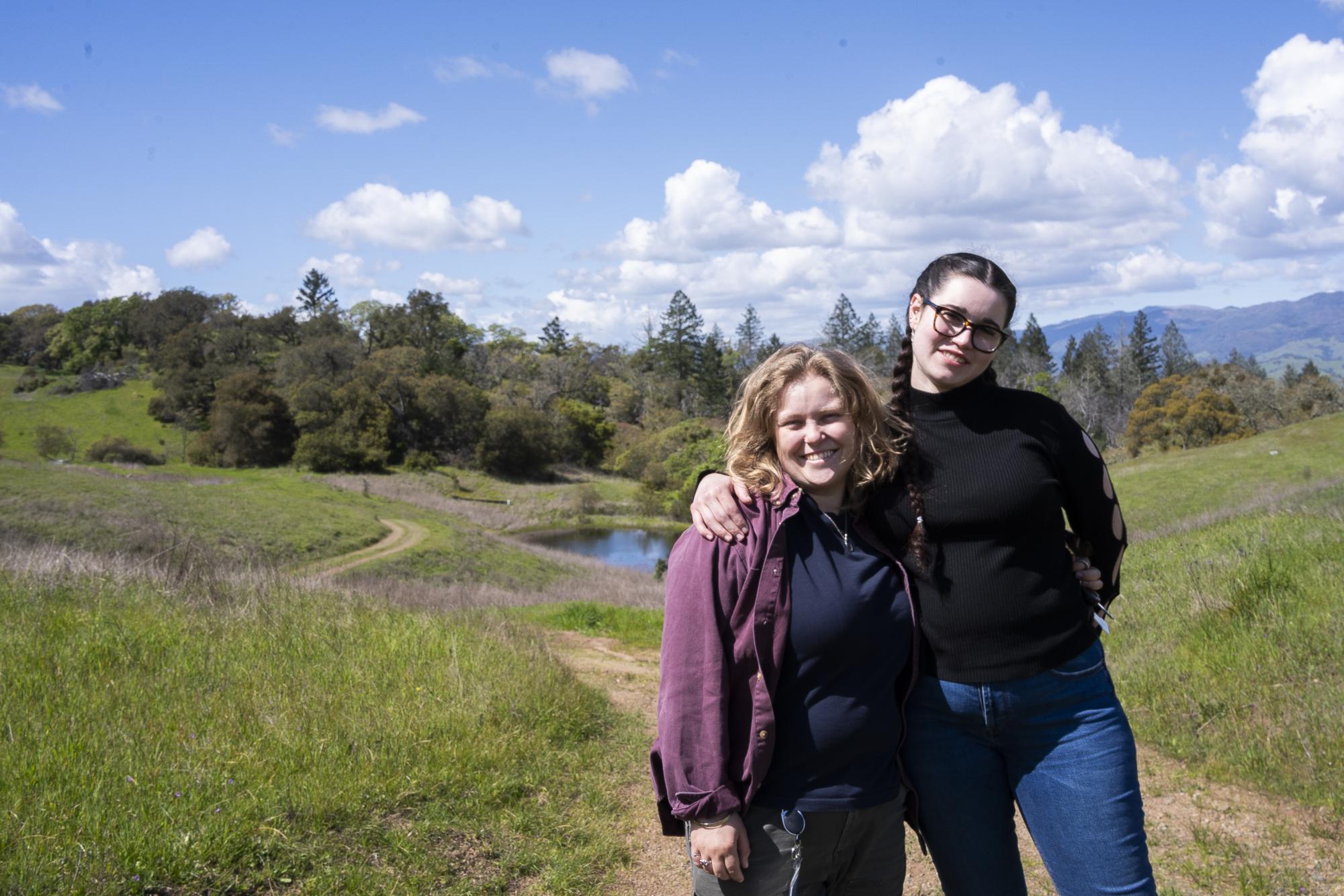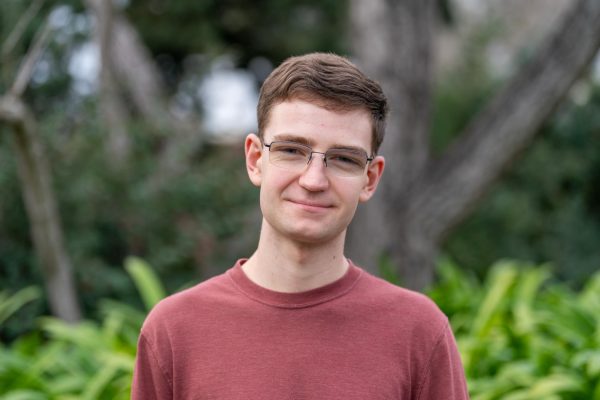After navigating 15 minutes down a bumpy gravel road cohabited by a herd of cattle, Santa Rosa Junior College students Bailey Glashan and Natalie Kozlowski pull into a small turnout and hop out of their car.
The duo follow the road on foot for a few minutes but quickly turn onto a game trail, stopping to admire native wildflowers. Sunlight peeks through a smattering of clouds above, illuminating oak trees and grassy, rolling hills, lush green from the winter’s rain.
Finally, they reach their destination: a patch of flowers hidden amongst oaks. Something catches Kozlowski’s eye, and she reaches for her bug net. After one fell swoop, she holds the net up for a better view before declaring success. A small black bee is in the mesh.
Glashan and Kozlowski are student interns at Pepperwood Preserve, a local site for ecological research, where their work focuses on native bees.
Nestled quietly in the Mayacamas Mountains of eastern Sonoma County and a mere 25-minute drive from Santa Rosa Junior College, the 3,200-acre Pepperwood Preserve is a hub for ecological research. Internships hosted in partnership with Santa Rosa Junior College allow students to participate hands-on with Pepperwood’s work.
Landowners Kenneth and Nancy Bechtel created the preserve in 1979 when they donated a plot west of Calistoga to the California Academy of Sciences. Nearly 30 years later, local philanthropists Jane and Herb Dwight purchased the property and established the Pepperwood Foundation, placing the land under the management of the newly-created foundation.
Though typically closed to the public, the preserve offers classes, volunteer opportunities and guided hikes. Some SRJC biology professors take their classes to the preserve, too.
However, research conducted by residential postgraduates and Pepperwood’s own ecologists is key to the preserve’s operations.
Steven Hammerich, a wildlife specialist with the preserve, described the site as “a living laboratory.” Pepperwood’s research focus is diverse. “We’re what’s called a sentinel site,” Hammerich said. “So we’re a site that does a lot of monitoring. We do climate monitoring, we do vegetation monitoring and we do wildlife monitoring.”
Glashan and Kozlowski work under Pepperwood’s Barnhart Herbarium Internship, a paid position that lasts for a year. Selected students create a research project that aligns with their interests.
The internship is named after Steven Barnhart, a retired SRJC professor who taught for 37 years. Barnhart and his wife, Linda, are still involved with activities at the preserve. He said that watching interns grow and succeed is “very gratifying.”
Shawn Brumbaugh, an SRJC biology professor, handles many of the logistics behind the internship. “If anyone is interested in doing any sort of resource management, conservation or ecology, just spending time in the field is essential,” Brumbaugh said.
After all, experiments don’t always go as planned, and the variability on the field teaches scientists to think on the fly.
“As an ecologist, you have all your plans of how something should work, and you get out there and it’s like, ‘This isn’t going to work,’” Brumbaugh said. “And then it’s a lot of problem solving, it’s like, ‘Okay, I need to study this system a little more and see how I need to adjust.’”
Brumbaugh also works with Pepperwood to clear the projects interns select. Though the autonomy of proposing research projects is valuable, there is also responsibility to consider.
“[Pepperwood] is limited in the amount of time and energy they can put into things, and so they have their set of objectives,” Brumbaugh said. “So we do want to be mindful of that, whatever the intern is doing, that it also benefits the priorities the preserve is setting.”
Glashan and Kozlowski’s project involves collecting bees from sites on both the SRJC campus and at Pepperwood Preserve.
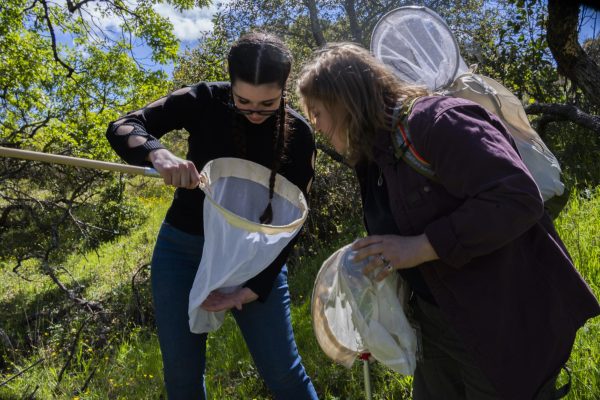
There’s a catch though. The project does not focus on bee species that most people think of, like the honeybee, which is not native to California, or even the bumblebee, which lives in large colonies. Their research focuses on a unique type: solitary bees.
As the name suggests, solitary bees live independently from other bees, with females building a nest and providing for young. Males, meanwhile, often sleep in flowers and emerge to mate with females. It’s a diverse category, accounting for around 90% of bee species in North America.
This variety is a large part of the reason Glashan, 21, enjoys researching insects. “I was blown away with the diversity you don’t even see,” she said.
The research begins in the field, where the process is simple. Glashan and Kozlowski scour key sites at Pepperwood and on campus for actively pollinating bees. Using bug nets and “kill jars,” containers with fumes fatal to the bees, they sample notable species.
The two then bring the bees into the lab where they identify specimens using a dissecting microscope. By collecting additional data, including the flower being pollinated and the day’s conditions, such as temperature, they get a better idea of the bee’s environment.
The goal is to help local bees thrive, said Jen Palladini, an SRJC instructor who oversees the work of students like Kozlowski and Glashan.
“If there are plants at Pepperwood, for example, that we find to be really important for a host for native solitary bees, it makes sense to try to plant some of those on campus so that we can better support the bees,” Palladini said.
Palladini, who has taught at SRJC for a decade, finds this research especially relevant in today’s world.
“Many of us have this idea that there’s the city and then there’s the nature, and the nature is for the wild species and the city is for people,” Palladini said. “As we expand our footprint out and out and out, we need to figure out how to better support wild species in areas where people are living.”
Human expansion is not the only threat to bees, Glashan added. She described a phenomenon called temporal mismatch in which changing climate factors cause bees to miss the window to pollinate.
“The bees die because they don’t get anything to eat, and the flowers die because they don’t reproduce,” Glashan said, describing the bee’s essential role as pollinators.
This is not Glashan’s first experience researching bees. The semester prior to obtaining her Pepperwood position, she began working on a project with a similar premise.
Though still fairly uncertain about her future, the Pepperwood experience has shown Glashan that she is passionate about both ecology and fieldwork. She’s interested in ecology “with special consideration and in the context of indigenous wisdom.”
Kozlowski says she also gained a lot from the internship. The exposure to research fields is important, but she highlighted how the opportunity helped her see value in natural lands.
“It’s been a very personal thing to research where I live and where I go to school,” Kozlowski said. “It’s given me an appreciation for native things… I’ve never felt more connected to Sonoma County.”
Glashan and Kozlowski are not the only students interning at Pepperwood through SRJC programs. A short distance from the bee-sampling site, a separate team of interns works in the gallery of Pepperwood’s Dwight Center, a multi-use facility within the preserve. Their mission is to sift carefully through thousands of photos in search of elusive wildlife.
Laid out across the preserve is a grid of trail cameras. The cameras are programmed to take bursts of photos when a sensor detects movement.
Members of the Conservation Science Internship (CSI), a program that’s entirely separate from the Barnhart Internship, are responsible for searching through massive volumes of pictures, often in the thousands.
This semester, SRJC’s Mathematics, Engineering and Science Achievement (MESA) program made two seats with the CSI internship possible. MESA, which aims to support first-generation, low-income STEM students, partners with Pepperwood as a part of its career development services.
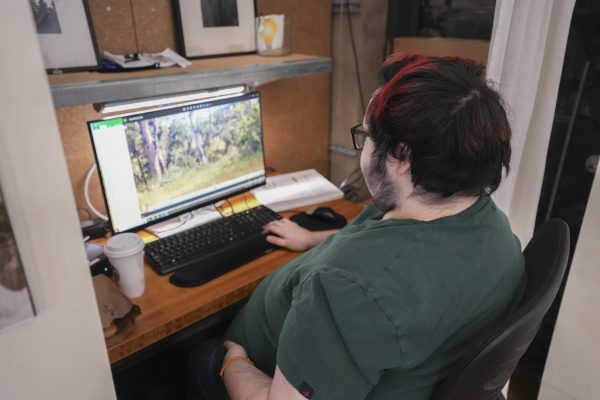
“Once they apply for scholarships or four-year universities, or even apply for other jobs, [students] are able to put [the internship] on their resume, which gives them the hands-on experience that other students may already have,” said Jessica Zambrano, manager of the MESA program.
That sort of marketable experience has proved perfect for student Oliver Murray, who had never interned prior to Pepperwood.
Murray, 25, started his journey at SRJC studying computer science but ultimately decided to switch his major after struggling in classes. He now takes biology courses with the hope of going into DNA forensics.
“I love organizing things and filling out a spreadsheet,” Murray said. He attributes this analytical mindset to both attracting him to the CSI program and success in the position.
Interns like Murray catalog images from the trail cameras by first identifying the animal in the picture. The image may be “blank” with no animal in the frame, or the observer might spot playful foxes or grazing deer. The intern then enters the information into a spreadsheet so researchers can track and analyze the data over time.
“It’s always something to laugh at or something to be curious about,” Murray said. “I’ve found I did not really have much of that in my life before.”
In one instance, Murray remembers working through a set quickly because a majority of the photos were blanks. “And then all of a sudden, like point blank, there were just two eyes and a nose,” Murray said, chuckling. “I screamed because it scared me.”
Murray is grateful for the opportunity. He advised students to put themselves out there. “Don’t be afraid to apply even if you think you won’t meet all the requirements or if you only want to do parts of it,” Murray said. “People are really accommodating, not just in a path forward but elsewhere. And the worst that they could say is, ‘No.’”
Besides working with image catalogs, CSI interns spend time roaming the preserve’s grassy expanse. The most common task is coverboarding, a technique where researchers rake the ground and then cover it with a plywood sheet. After a waiting period, a researcher flips over the cover board and records the species underneath.
Savoth Chea remembers the first time he flipped over a coverboard. “The first one I lifted up, I saw a red salamander, and I was shocked, a scorpion,” he said. “I thought in my mind that scorpions are only in the desert like Arizona or Texas, but not here. And there was a beautiful-looking scorpion.”
Chea is the second CSI intern participating through MESA. At 45, Chea is also a returning student.
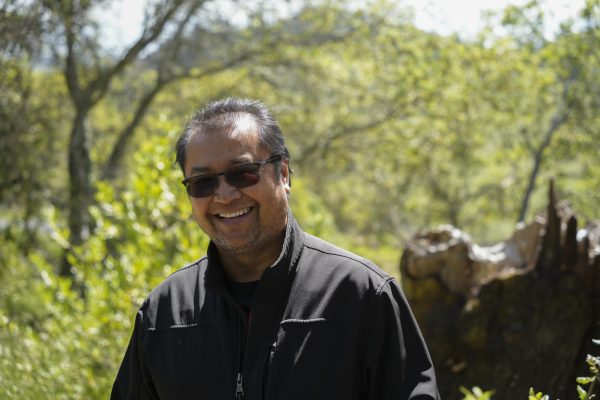
Born in Cambodia, Chea’s family fled violence and instability associated with Khmer Rouge, a totalitarian and genocidal regime, when he was about 6. Among a family of six siblings, only Chea, his mother, grandmother and sister survived.
“I never met my dad,” Chea said. “My only recollection of my dad was the shadow from sitting on his shoulder walking down the market shooting little rubber bands.”
In the U.S., Chea began working at a young age. He struggled to find direction in his SRJC classes and did not progress far. Still, he found his way into various lab tech positions, including working at Hewlett Packard manufacturing circuit boards and Thermo Fisher testing pipetting equipment.
However, his lack of formal education limited his ability to progress within these jobs. When the COVID-19 pandemic struck, Chea assumed the responsibility of watching his young grandniece. It was then that his perspective shifted.
“I realized you have to do something for yourself,” he said. “Don’t be so scared, and then you have to leave a legacy behind.”
Chea has since returned to SRJC and is taking classes to pursue a career change to astronautical engineering, a field that focuses on developing spacecraft. He’s deeply passionate about the topic, and is now at Pepperwood to gain internship experience before transferring to a four-year university.
As Chea sees it, there are links between the grassy expanses of Pepperwood and the depths of space. Not only is the data management side of wildlife cataloging reminiscent of engineering work, Chea also likes to consider how satellite photography can support conservation.
“We’re like a fish in an aquarium,” Chea said. “There’s only a certain amount of resources. I want to think about how we can use space technology to help us eliminate wastefulness.”
Adrian Cabrera-Cortez, 19, also shares a deep passion for conservation. “Healthy biodiversity creates healthy ecosystems, and healthy ecosystems provide the services that we need for our societies to function,” Cabrera-Cortez said. “They give us our water, our food, our air.”
Cabrera-Cortez remembers his connection to ecology starting at a young age. “My mom brought home the original ‘Planet Earth’ series on a DVD,” he said, “and I watched that thing straight—all the episodes, every second, and just re-watched it for years.”
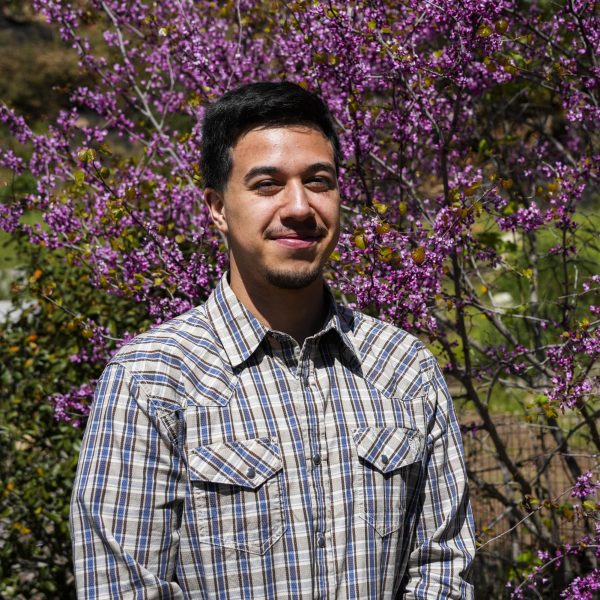
Interested in the effects native and invasive plants have on ecosystems, Cabrera-Cortez set up an at-home project by planting a plot of native wildflowers and documenting their growth. He’s also working on a short documentary to capture the project. “[The wildflowers] get the rain when it comes, but when it’s not there they don’t need it, and they grow up beautiful,” Cabrera-Cortez said. “I see it as a win-win in all regards; little effort, high reward.”
Being the newest intern on site, Cabrera-Cortez is still learning the ropes. But either way, he admires the ongoing work at Pepperwood.
“I think [Pepperwood] is doing great things that will reverberate further than just our couple thousand acres,” Cabrera-Cortez said.
Kevin Brady and Jacob Lewis have both been CSI interns for just shy of two years. Both have ties to SRJC, with Brady having received a natural resource management certificate and Lewis being a current student.
As veterans of the program, they have their share of lessons to teach. Lewis, in particular, enjoys how there’s always so much to learn. “It’s that mentality, combined with the rigorous outdoor therapy that we get here, is addicting to me, like spending my time around curious scientists and getting to experience the outdoors,” Lewis said. “It’s this low rumble of spirituality that I get out here that the Earth is just here.”
The two also have stories from the field. Brady recounted lifting up one coverboard to find a surprise underneath: a rattlesnake. “I kind of froze. And my partner was like, ‘Slowly put the board back,’” Brady said. “You really do have to be careful when you lift up cover boards. And there are things out here that can hurt you.”
Whatever wisdom the pair has to offer, they’ve begun to step into more of a mentoring role for the program’s newcomers. Though Hammerich spearheads the program, they’ve been able to help out by teaching. “
For a while now, I’ve felt like I get to teach interns, and I love training and teaching. It’s my jam,” Lewis said.
Brady appreciates putting the work of the team into context. “We’re kind of a part of something bigger,” he said.
That “something bigger” is evident in all the ongoing projects, be it wildlife monitoring, coverboards or bee studies.
At Pepperwood, ecologists have a unique sandbox, a place to experiment with different variables and quantify the results.
Take coverboards. By making initial observations about what’s popping up underneath the coverboards, Hammerich said, Pepperwood scientists can use those results as a baseline and begin tinkering with the conditions.
“You go in there and you do a bunch of thinning, so you’re cutting down a bunch of trees and stuff,” he said. “And then you can see how that might be affecting them. And then you burn it, and then you can see how it’s affected after burning.”
No one method works in isolation. Alongside coverboards, data from trail cams gives another perspective. “Overtime, we can see how wildlife are using different vegetation communities,” Hammerich said.
Independent projects, like that of Kozlowski and Glashan, further refine the scope of the picture. Ecologists gain understanding of what types of flowers bees are pollinating and what species are out there.
Based on those results, Pepperwood scientists draw conclusions. “Then you can say with some level of confidence that the things we’re doing in the forest are having no impact on the wildlife, or they are having a negative impact, or they are having a positive impact,” Hammerich said.
It’s like putting together a giant puzzle. And students get to play hands-on roles in making that puzzle come together, which can be valuable in exploring interests and building roots in the field. This is something Hammerich, a former SRJC student, finds important.
“I’ve seen lives change here. Not kidding, I’ve seen students come here who didn’t know that they were as passionate as they were about conservation science,” he said. “I get to see them later when they start their careers in the field. And I get to know that I’ve been a small part of that. It’s very rewarding.”




